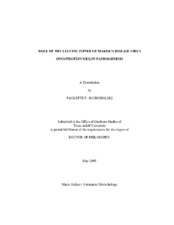| dc.description.abstract | Marek's disease virus (MDV), the etiologic agent of Marek's disease, is a potent
oncogenic herpesvirus. MDV is highly contagious and elicits a rapid onset of malignant
T-cell lymphomas in chickens within several weeks after infection. The MDV genome
encodes an oncoprotein, Meq, which shares resemblance with the Jun/Fos family of
bZIP transcription factors. Similar to c-Jun, the leucine zipper region of Meq allows the
formation of homo- and heterodimers. Meq homo- and heterodimers have different DNA
binding affinities and transcriptional activity; therefore, they may differentially regulate
transcription of viral and cellular genes. Previous in vitro data has suggested that Meq
homodimers may be involved in regulating viral latency/reactivation, while Meq/c-Jun
heterodimers are involved in transformation. Therefore, this research investigates the
role of Meq homodimers and Meq-Jun heterodimers in the pathogenicity of MDV, by
generating chimeric meq genes, which contain the leucine zipper region of the yeast
transcription factor GCN4 (meqGCN) or leucine zipper region of c-Fos (meqFos). Thus
producing Meq proteins that exclusively homodimerize (MeqGCN) or heterodimerize
with Jun family members (MeqFos). Recombinant viruses (rMd5-MeqGCN and rMd5- MeqFos) containing the chimeric genes meqGCN or meqFos, respectively, in place of
parental meq were generated with overlapping cosmid clones of Md5, a very virulent
MDV strain. The chimeric genes were evaluated in vitro and retained DNA binding and
transactivation/repressive functions, however, selected cells expressing MeqGCN and
MeqFos had reduced colony formation in soft agar. Both the rMd5-MeqGCN and rMd5-
MeqFos viruses replicated in vitro and in vivo, but rMd5-MeqGCN was unable to
transform T-cells in infected chickens, while rMd5-MeqFos induced preneoplastic nerve
lesions in 50% of infected birds. However, a third virus rMd5-MeqFos/GCN, which
contains one copy of each meqGCN and meqFos, induced preneoplastic nerve lesions in
60% of infected chickens and neoplastic lesions in 20% of infected chickens. These data
provide the first in vivo evidence that both Meq homodimers and heterodimers are
necessary for MDV induced transformation. | en |


